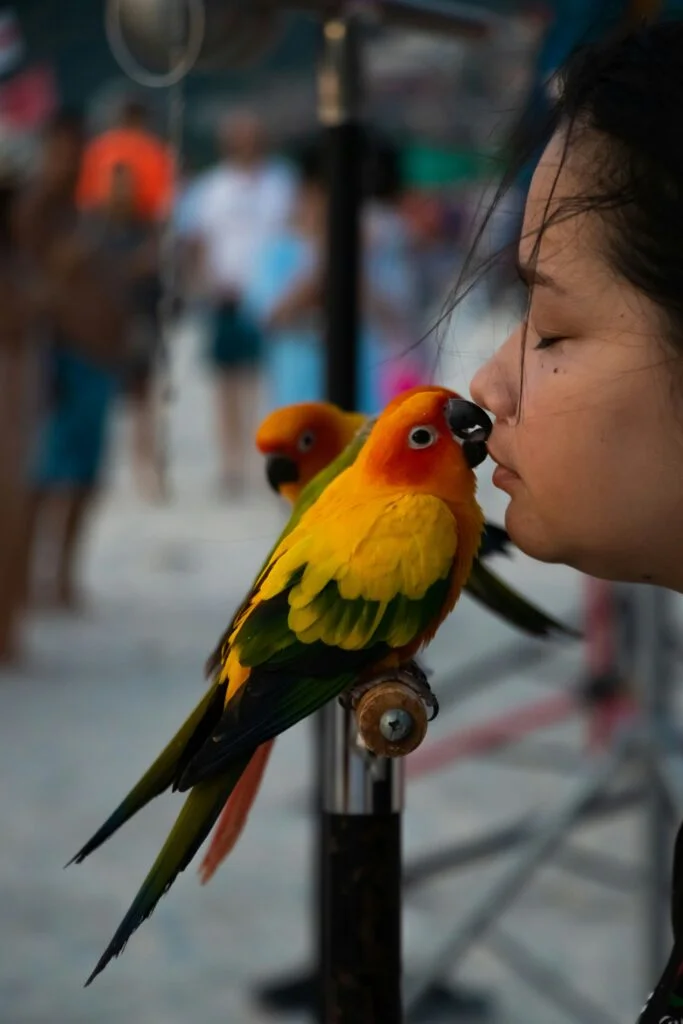The Backstory
The journey that led to the entangled connection between my parrot and my toxic ex-boyfriend began several years ago, during the nascent stages of our relationship. From the outset, our relationship was marked by intense emotions, leading to moments of joy but overshadowed by frequent turbulence. Throughout this time, my parrot, a vibrant African Grey named Rio, became an integral part of my everyday life, often serving as an unwitting witness to the tumultuous dynamics between my ex and me.
Rio’s keen intelligence and remarkable ability to mimic sounds and phrases made him a constant presence during arguments and heartfelt exchanges. Sadly, these moments often veered into emotionally charged territory. Whether it was the echoes of my ex’s biting remarks or our more passionate exchanges, Rio absorbed every inflection and tone like a linguistic sponge. He was not only a companion but also an innocent bystander to a relationship that was increasingly fraught with negativity and emotional strain.
The eventual decision to part ways came after numerous attempts to salvage the relationship. It was during these pivotal moments that Rio experienced the deepest emotional shifts alongside me. As I navigated through the heartache and despair, he mirrored some of the coping phrases I unconsciously repeated in an effort to soothe myself. Over time, these utterances became etched into his verbal repertoire, allowing him to mimic everything from my frustrated sighs to my attempts at affirmations during that distressing period.
The aftermath of the breakup was challenging and emotionally charged, not only for me but for Rio as well. The echoes of my toxic relationship lingered in our home, and, unfortunately, in Rio’s voice. As I attempted to heal and redefine my life, I realized that his mimicry wasn’t just amusing; it was a poignant reminder of the emotional damage that had both shaped our lives. This reflection has made me reflect on the profound connections we often share with our pets, and how they can encapsulate the emotional experiences we endure.
Parrot Lived Through the Breakup
The emotional landscape surrounding a breakup can have a profound impact not only on people but also on their pets, particularly animals as perceptive as parrots. These birds possess a keen ability to pick up on the emotional states of their owners, making them sensitive observers of their environments. During tumultuous times, such as a relationship falling apart, these emotions can create a charged atmosphere that a parrot cannot help but absorb. For instance, if arguments were frequent during the breakup, the parrot likely observed the heightened tension, noting the tone of voice and body language associated with conflict. Over time, these experiences can become ingrained in their memory, shaping their future behaviors.
Moreover, parrots are social creatures and often mirror the behavior of those around them as a form of bonding or communication. When they witness signs of distress, they can exhibit changes in their own vocalizations and actions. If the owner often expressed feelings of sadness or frustration, the parrot, in turn, may adopt a more somber tone, reflecting those negative emotions. This mimicking behavior can manifest in both vocalizations and actions, which can inadvertently remind the owner of the relationship’s emotionally charged moments. The parrot’s ability to echo phrases or sentiments associated with their past experiences can contribute to a cyclical pattern of emotional distress for the owner.
These instances reveal the significance of the parrot’s memories and how they are intricately linked to the emotional experiences shared with their human. The consistently replayed echoes of arguments or sad phrases can serve as a painful reminder of prior turmoil. As both the owner and the parrot navigate the aftermath of a toxic relationship, the emotional damage can, regrettably, seem to be on an unending loop, reinforcing the need for a healing process that benefits both parties involved.
What It Says Now
Having a parrot is often considered a source of joy and companionship, but when the phrases it mimics echo words of a toxic ex-partner, the experience can verge on the surreal. My parrot has adopted several distressing lines that were frequently used by my former partner, creating an environment where I am constantly reminded of the turbulent relationship. The phrases it has begun to mimic include, “It’s not you, it’s me” and “You’re overreacting.”
The phrase “It’s not you, it’s me” was often employed by my ex to deflect accountability, a statement rife with emotional manipulation. It essentially served as a way to remove responsibility from their actions, suggesting that I was at fault for the problems we encountered, rather than addressing their behavior directly. Hearing my parrot replicate this phrase has unearthed feelings of frustration and inadequacy, reminding me of the gaslighting that characterized that relationship.
Similarly, the phrase “You’re overreacting” has surfaced during interactions with my feathered companion, a statement my ex frequently used to dismiss my feelings. In moments of genuine concern or distress, this phrase was a weapon, utilized to invalidate my emotions rather than facilitate constructive dialogue. When my parrot mimics this phrase, it feels as though I am once more subjected to the emotional turmoil of that relationship, leading to a sense of helplessness.
Encounters with my parrot have transitioned from being lighthearted and entertaining to ones clotted with emotional weight. Each verbal repetition serves as a continuous reminder of the phrases that once caused me deep psychological harm, now unintentionally echoed through my pet’s innocent mimicry. This emotional damage on loop has invariably complicated my journey toward healing and self-acceptance.
The Impact of Mimicking
The startling occurrence of my parrot mimicking phrases from my toxic ex has had a profound effect on my daily life, triggering a cascade of emotions that fluctuate between humor and despair. Parrots are known for their remarkable ability to imitate sounds and speech, but my feathered companion seems adept at evoking memories that I would rather forget. Hearing the familiar, albeit unwelcome, phrases repeatedly has transformed simple moments into emotional battlegrounds.
Initially, the mimicry sparked laughter; it felt almost surreal to witness a small creature reciting words that once filled my life with turmoil. However, as the novelty wore off, each utterance seemed to resonate with echoes of conflict, resentment, and ultimately, regret. The humor began to fade, replaced by a sense of nostalgia that I was unwilling to confront. This tug-of-war between amusement and emotional distress has cast a long shadow over what should be lighthearted interactions with my parrot.
Moreover, the parrot’s mimicry has instigated confusion, as I grapple with feelings associated with my past relationship. Through the parrot’s persistent repetition, I’m drawn back to moments that shaped my emotional landscape, forcing me to relive experiences that are intertwined with pain. The cheerful chirps that once brought joy are now haunted by whispers of heartbreak. I find myself oscillating between the desire to enjoy the company of my pet and the increasingly burdensome reminder of my past.
This emotional turmoil stands as a testament to the complex interplay between love, loss, and healing. Each phrase echoed by my parrot thrusts me into a reminder of my history, leaving me to navigate a path of emotional oscillation. Ultimately, the impact of mimicking has underscored my struggle to dissociate from the past while attempting to embrace the simple pleasure of companionship.
Emotional Toll
Living with a parrot that mimics the voice of an ex-partner can create a paradox of emotions. On one hand, the unexpected humor in the parrot’s imitations can evoke laughter, while simultaneously stirring feelings of sadness and betrayal. The sounds echoing through the house are reminders of the tumultuous relationship that has left its mark. Each mimicry can spark memories, causing a conflict where humor dances with hurt, creating a cycle of emotional response that is difficult to manage.
As the parrot repeats phrases and tones, the laughter that arises from its antics can quickly shift into a painful reminder of the past. This duality of emotions can be disorienting; one moment, it feels like an innocent joke, and the next, it triggers a cascade of hurtful memories. The juxtaposition of joy and sadness makes it challenging to navigate daily life, especially in moments when the parrot chooses to mimic particularly biting remarks or sentiments that originated from a place of toxicity. It is almost as if the parrot is reliving those hurtful exchanges, amplifying the emotional toll that was already present.
This unique experience creates a loop of emotional turmoil, wherein laughter can morph into tears in an instant. The comic value of the mimicry might offer brief moments of levity, yet the underlying pain remains palpable. It is as if the parrot has become an unintended reminder of a flawed relationship, causing the mind to revisit past grievances while resisting the urge to laugh at the absurdity of the situation. Such instances underscore the complexity of emotions involved, revealing how intertwined laughter and sorrow can be when confronted with echoes of the past that persist in the present.
Visitors Think I’m Cursed
Since my parrot began imitating the phrases and mannerisms of my toxic ex, the dynamic in my home has shifted in unexpected ways. Friends, family, and even occasional visitors have expressed their surprise and amusement when they hear my parrot chirping out words that echo my past relationship. Their reactions range from laughter to genuine concern, many jokingly suggesting that I might be cursed or haunted by the lingering spirit of my former partner. This blend of humor and empathy has created a unique atmosphere, where absurdity dances alongside the remnants of a painful chapter in my life.
At first, I found myself feeling embarrassed by the parrot’s mimicry, replaying past arguments and negative comments with such precision that it rattled my emotional compass. However, as friends gathered in my living room, their laughter quickly turned the discomfort into amusement. “It’s like he’s auditioning for a role in your life story,” one friend remarked, prompting others to chuckle. This response helped me see the humor embedded in the situation, shifting from a place of annoyance to one of camaraderie.
Many visitors have interpreted my parrot’s mimicry as a cautionary tale against toxicity. Comments such as, “It’s a warning not to go back to that kind of drama,” have become commonplace, merging lighthearted jests with deeper reflections on emotional resilience. My home has transformed into a space where the weight of the past coexists with laughter and lessons learned. In what could easily be a sorrowful reminder of lost happiness, my parrot’s antics have allowed me to face my history with a smile, proving that even the most challenging experiences can foster connection and levity in unexpected ways.
Coping Mechanisms
The experience of living with a parrot that mimics the voice and phrases of a toxic ex-partner can be extremely challenging. To cope with the emotional stress caused by this situation, one can employ several effective strategies. Seeking support from friends and family is an essential step. Sharing feelings and experiences with trusted individuals allows for validation of emotions and encourages healing. A supportive network can provide different perspectives and insights that may help one move forward.
Engaging in self-care practices is another vital coping mechanism. Activities such as mindfulness, meditation, and yoga can aid in grounding oneself during emotionally turbulent times. Mindfulness encourages living in the present moment, which can be particularly beneficial when triggered by memories of the past. Additionally, pursuing hobbies or interests that bring joy can serve as a distraction and enhance emotional well-being. Creating a routine that includes regular self-care activities promotes a healthier mindset, and helps in managing stress effectively.
Addressing the underlying issues related to the toxic past can also play a crucial role in emotional healing. This may involve exploring feelings through journaling or therapy, allowing individuals to process and understand their experiences. Therapeutic practices can provide valuable coping strategies tailored to personal needs. Developing emotional resilience is key in navigating the fallout from past relationships. Acquiring new skills to build emotional intelligence, such as recognizing and regulating one’s emotions, can significantly improve how one deals with triggers in the present.
Combining these approaches can lead to a more comprehensive coping plan that fosters recovery and emotional balance. By seeking support, practicing self-care, and addressing the emotional scars of a toxic past, individuals can regain control and improve their quality of life even amidst challenging situations.
Lessons Learned
This unusual situation with my parrot has served as a profound catalyst for introspection and personal growth. Initially, I was taken aback by the bird’s ability to mimic the words and phrases of my former toxic partner. However, this mimicry has ultimately prompted me to evaluate my past relationship and its lingering impact on my mental health. It made me realize that understanding the dynamics of toxic relationships is essential not only for personal healing but also for future emotional well-being.
The moment my parrot began to repeat phrases that I had once associated with hurt and manipulation, it became clear that certain memories were still very much alive. This exaggerated reflection of my past, albeit through the lens of avian mimicry, encouraged me to confront and analyze feelings that I had previously pushed aside. I learned that recognizing the effects of past relationships is crucial in moving forward; it allows for an honest assessment of how they shape one’s perceptions, interact with current relationships, and influence self-worth.
Moreover, this experience highlighted the importance of finding closure. Engaging with a pet that homaged to a negative chapter of my life manifested the need to process unresolved emotions. Rather than shying away from these feelings, I embraced them, allowing my parrot’s antics to symbolize the journey toward acceptance and emotional freedom. The bird, unknowingly, became an accomplice in my healing process, prompting me to advocate for my own mental health, break the cycle of toxicity, and redefine my relationship with love and companionship.
Ultimately, these lessons have reaffirmed the necessity of setting boundaries and prioritizing emotional safety. They remind me that healing is an ongoing process, influenced by awareness, reflection, and the recognition of past experiences—regardless of whether they emerge as vivid memories or through the innocent mimicry of a parrot.
Moving Forward
As I navigate the emotional complexities stemming from my past relationship, I find myself embracing the importance of moving forward. The experience with my parrot mimicking phrases from my toxic ex has highlighted the need for growth and healing in my life. It is essential to focus on the positive aspects of my journey and to reshape my environment to foster uplifting experiences. I aspire to cultivate a mindset that prioritizes personal well-being and emotional resilience.
One key aspect of my plan involves actively training my parrot to mimic more positive and encouraging phrases. The process will not only enrich my parrot’s vocal repertoire but will also serve as a therapeutic exercise for me. By introducing uplifting phrases and nurturing affirmations into our daily interactions, I believe I can drown out the negative echoes of the past and replace them with messages of hope and positivity. This adjustment will create a vibrant atmosphere, fostering a sense of peace and happiness in our shared space.
Furthermore, embracing hobbies and social engagements that uplift my spirit will be foundational to my recovery. Whether it’s participating in community events, indulging in creative outlets, or simply spending time in nature, these positive experiences can be transformative. I aim to surround myself with individuals who uplift and inspire me, building a supportive network that champions emotional growth and healing.
It’s vital to recognize that overcoming emotional damage from a toxic relationship is a journey. Each day presents an opportunity to reinforce a healthier mindset and create a brighter future. The echoes of my past might still linger, but they no longer have the power to define my present. As I focus on training my parrot to reflect joy and positivity, I am reminded that healing is possible, and a fulfilling life awaits on the other side. Every step taken toward emotional well-being is a step toward a healthier, more joyful existence.

It could cover a range of topics related to health, wellness, beauty, personal growth, and social issues, all from the perspective of striving for beauty, intelligence, youthfulness, and impartiality





